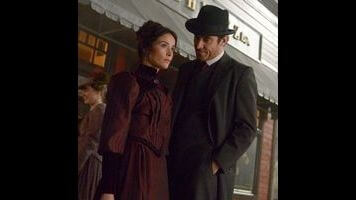Lucy doesn’t need saving on an overstuffed Timeless

Timeless is back, and for the most part, it’s business as usual. There’s one small change, however, and it’s one that could mean big (and positive) things for the show in the weeks to come. Thanks to Lucy’s interference, Flynn’s goal is now to take down Rittenhouse, one member at a time—a simplification that will beautifully serve the history-of-the-week format while freeing time up to deal with the bigger, badder mysteries (and big bads). Now Flynn’s got a list, and he’s checking names off one by one. In this case, it’s actually three by three, as the list begins with Thomas Edison, Henry Ford, and J.P. Morgan
That seems like more than enough for one episode, no? Not on Timeless. This series isn’t wanting for areas where it could step things up a bit, but you can’t say they don’t go for broke. As it turns out, episode writer Lana Cho doesn’t bother much with those three titans. Instead, she zeroes in on the 1893 Chicago World’s Fair, an event that started turning up in fiction and pop culture a lot more after 2003, when Erik Larson’s hugely successful The Devil in the White City became one of those books that everyone on public transit seems to be reading simultaneously. The book looks at the creation and experience of the fair, and at those who built and visited it, but the figure that has loomed largest since its publication is that of serial killer H.H. Holmes. Timeless picked a hell of a monster for its heroes to face down, yet another villain in the show’s steadily expanding stable.
The idea that Timeless would pay a visit to the Fair and not swing by the murder hotel is a ludicrous one, so it’s no surprise that he turns up. What is surprising is how little time we spend with him. Cho’s enthusiasm pays dividends—this is an entertaining, hour, to be sure—but it also wounds “The World’s Columbian Exposition,” because there’s so much going on that we don’t spend much time with anyone. At first, the story ricochets between Flynn/Lucy and Wyatt/Rufus, but even once they’re all ostensibly in the same place, there’s precious little time to get invested in anything. With one notable exception, the scenes are quick and to the point. Een that’s not what really hurts this episode’s momentum and ability to compel. No, what really hobbles this thing is its single most inspired inclusion: Harry Houdini.
Who can upstage H.H. Holmes? Harry freakin’ Houdini, that’s who. Nearly all of the momentum in “The World’s Columbian Exposition” come courtesy of Houdini and actor Michael Drayer (Mr. Robot), which is what you expect when you take a compelling historical figure on the level of this one and put him in the hands of an actor who knows the value of underplaying things. Drayer’s Houdini is mild-mannered with just a hint of the showboat about him, and his scenes, particularly those with Abigail Spencer’s Lucy, sparkle in a way that others in this episode don’t. That’s no fault of the cast—this remains a sorely underrated ensemble—but instead one of biting off more than one can chew, of packing in so much that almost nothing can be appreciated on its own. There’s almost no room to savor. One of the world’s first modern serial killers, a murder castle, a renowned female architect, a time-traveling trio and the psychopath chasting them, and oh, yes, Rittenhouse. That’s more than enough before you add on the world’s foremost escape artist and magician. Houdini, wonderful as he is to watch here, is the straw that broke the time-travel show’s back.

 Keep scrolling for more great stories.
Keep scrolling for more great stories.